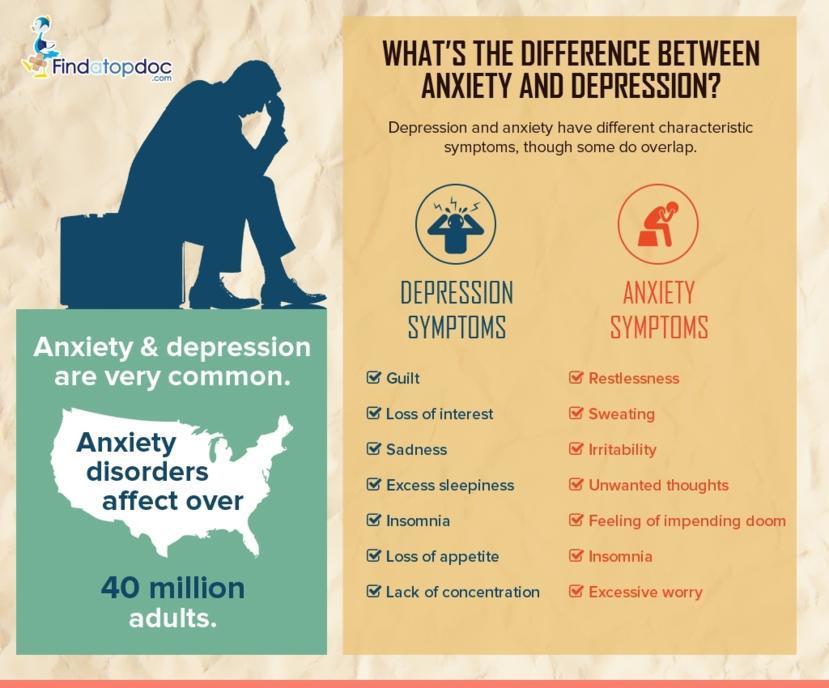Learning About the Beck Depression Inventory

Depression and Anxiety
Depression and anxiety are disorders that are different from each other, but people suffering from depression often have symptoms that closely resemble those of anxiety. The disorder, in fact, starts out as anxiety, and if not treated at the right time with the right diagnosis, it will lead to depression and then to severe depression.
Nervousness, irritable bowel syndrome, heart palpitations, headaches, migraines, sweating, irritability, escaping from social gatherings, hopelessness, a feeling of emptiness, sleeplessness, loss of concentration, feelings of guilt, feelings of uselessness and the futility of life, experiencing negative thoughts all the time, the death of a close relative or loved one, and feeling frustrated are all related to anxiety. Students during their examinations usually have one or more of these symptoms. Once their exams are over, the symptoms disappear on their own. Sometimes, patients who are in a hospital undergoing treatment will go into depression because of their surroundings and seeing other suffering patients.
In many cases, untreated anxiety may lead to depression and also severe depression. Sullenness, sitting quietly by themselves, not eating well, not opening up to family members, lethargy, not mingling with their circle of friends, and dark circles under the eyes are all symptoms in people with depression. Failing in an exam, losing a job, not getting employment, a broken relationship, broken marriage, parents always quarreling at home, no money to spend, a long list of loans, and so on, can bring on depression easily. If the person is not emotionally stable, cannot take failures in stride, cannot plan well for their life, and loses their temper very easily – all these can lead to depression in the long run. Sometimes, doctors get overwhelmed to see that there are no obvious reasons for a person to have anxiety or to feel depressed. These patients will go through this disorder without any reason whatsoever.
Diagnosis and treatment are essential for depressed patients. Each disorder and each person will have to be diagnosed properly after tests on emotional, psychological, and behavioral patterns are conducted on them. A careful study of the patient's medical history is also always undertaken.
A person may feel irregularities of his or her heartbeat if he is naturally a timid person and fears facing life. He may hear of a death in the neighborhood and start feeling heart palpitations, which will make his family run to their doctor seeking advice.
Depression is a syndrome that has a variety of causes, some of which are present with specific somatic complaints such as headache, migraines, changes in appetite, sexual dysfunction, chronic pain, digestive problems such as diarrhea and constipation, fatigue, and sleep disturbances.
Conducting a comprehensive screening for all types of depressive disorders instead of only screening for major depressive disorders can lead to a successful diagnosis, treatment, and referral in the primary care setting. Moreover, it would also help patients who have depression with a few or no symptoms at all, but many somatic or physical ones.
What is a Beck Depression Inventory (BDI)?
The earlier the treatment begins, the more effective it will become. Hence, learning about different evaluation tools to assess depression plays a key role in the treatment process. One of the most widely used self-rating scale to assess depression is the Beck Depression Inventory. There are various depression tests available for assessing the extent of depression, but the widely accepted one is the Beck Depression Inventory.
The Beck Depression Inventory (BDI) consists of 21 items relating to emotional, behavioral, and somatic symptoms that take 5-10 minutes to complete. Worldwide, the Beck Depression Inventory is the most extensively used self-administered tool. Aaron T. Beck developed this self-rating tool in 1961.
The BDI was created to evaluate the intensity of a person’s symptoms, which are mostly associated with psychoanalytic aspects of depression. Its aspects include feelings of guilt and failure, sadness, suicidal thoughts, social withdrawal, lack of satisfaction, pessimism, sense of punishment, self-hate, self-accusations, self-punitive wishes, crying spells, irritability, indecisiveness, body image, work inhibition, sleep disturbance, fatigue, loss of appetite, weight loss, loss of libido, and somatic preoccupation.
BDI is an assessment of the severity of a case of depression using the Diagnostic and Statistical Manual of Mental Disorders (DSM) criteria. BDI assesses the intensity of depression in clinical and normal people. Each item is a list of four statements arranged in increasing severity about a particular symptom of depression. The items are scored from 0 to 3. Scores of 10-18 indicate mild depression, 19-29 indicate moderate depression, and greater than 30 indicate severe depression.
Just like the Beck Depression Inventory, most depression questionnaires primarily screen for emotional symptoms. Although such screening tools are useful, they should not be a substitute for clinical judgment. It is estimated that there are twice as many women who are diagnosed with depressive disorders compared to men. Social norms for both the expression and interpretation of depression are reflected in the Beck Depression Inventory’s terms that screens for depression symptoms, which are stereotypically associated with the female gender norms rather than male gender norms. The symptoms include feeling guilty, crying, being indecisive, somatic preoccupation, and loss of libido. Men may not perceive themselves or be perceived as depressed if their sex role prohibits them from using conventional terms to describe specific emotional problems.
This might pose a challenge in the use of standard screening tools such as the BDI for the detection of depression in men. The use of Beck Depression Inventory might encounter obstacles for certain demographic groups and cultures. The validity of the BDI result may be diminished due to the effects of translation from English to other languages, patients may have different interpretations on the emotional terms, and various cultural factors may come into play.
Beck Depression Inventory version II is the current version, released in 1996. The first version, released in 1961, can be downloaded, but the questionnaire has to be administered by a professional and trained medical health personnel, as self-administration and analysis of one's own results are less likely to be objective and accurate.
There are a number of screening tools that are useful in identifying the symptoms of depression, but further investigations must be carried out to confirm a clinical diagnosis of depression. The final diagnosis should take into account any physical illness as well as emotional problems after a careful questioning of the patient. Treatment with medication, counseling with trained doctors in the relevant field, and regular monitoring of the progress of the patient are all recorded and studied to point the patient's way down the road to recovery.










